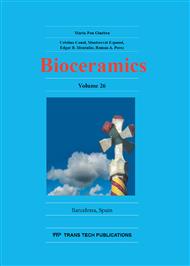p.179
p.184
p.193
p.198
p.202
p.207
p.212
p.216
p.225
Nanostructured Bone Grafting Substitutes Versus Autologous Cancellous Bone – An Animal Experiment in Sheep
Abstract:
In an In vivo study the full synthetic bone substitute NanoBone® S (NBS) was analyzed using a standardized bone defect (6 x 12 x 24mm) model in the ovine tibial metaphysis. The defect on the left side was filled with NBS granules and on the right side, autologous bone, harvested from the hip of the same animal, was inserted. After six, 12 and 26 weeks sheep were sacrificed and the tibiae analyzed. Quantitative histomorphological analysis after six weeks showed a resorption of biomaterial from over 60 to 24 percent. In contrast the bone formation after 6, and 12 weeks revealed an osteoneogenesis of 19%, and 34%, respectively. Hematoxylin and eosin sections demonstrated multinucleated giant cells on the surface of the biomaterial and resorption lacunae, indicating osteoclastic resorptive activity.
Info:
Periodical:
Pages:
202-206
Citation:
Online since:
November 2014
Authors:
Price:
Сopyright:
© 2015 Trans Tech Publications Ltd. All Rights Reserved
Share:
Citation:


